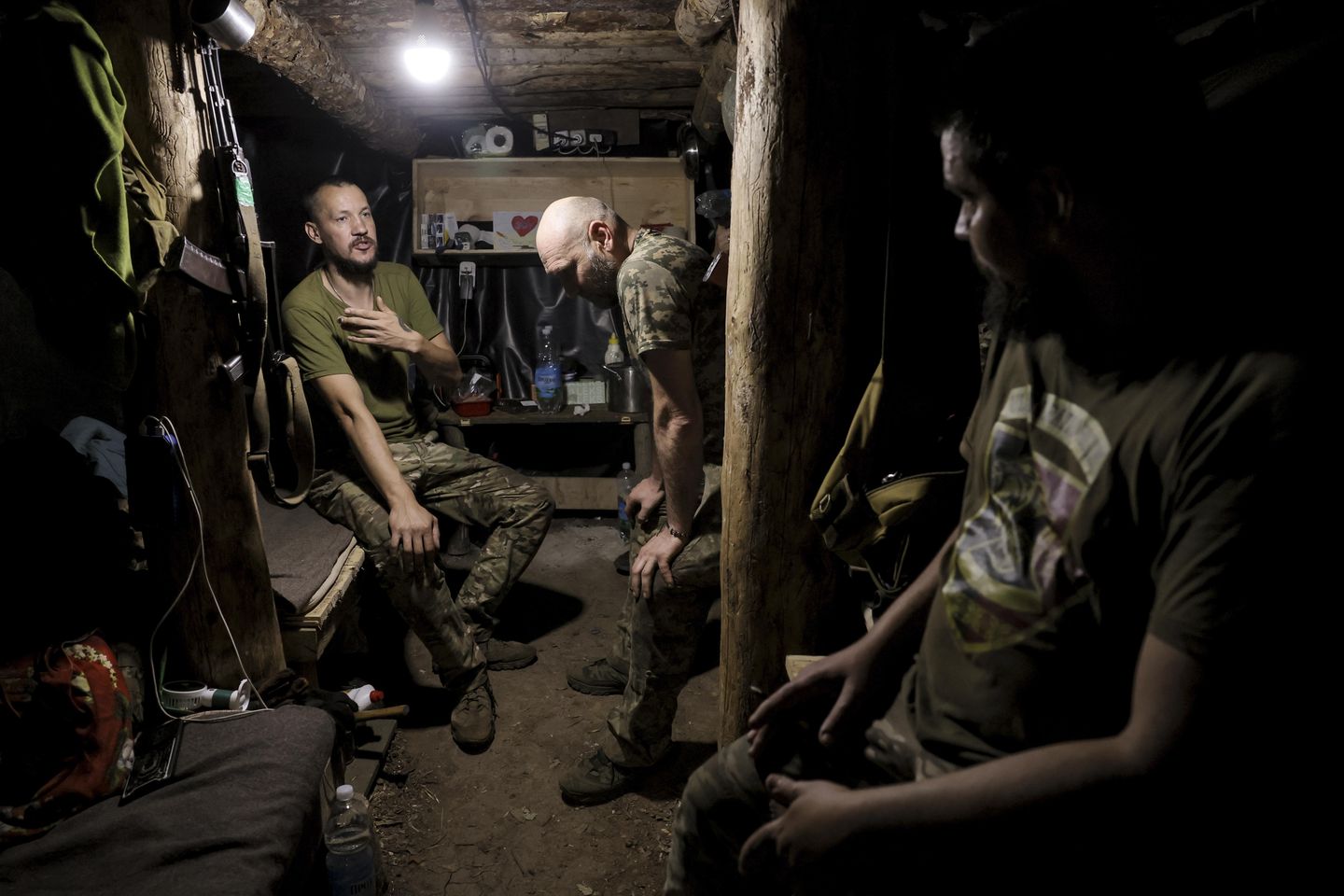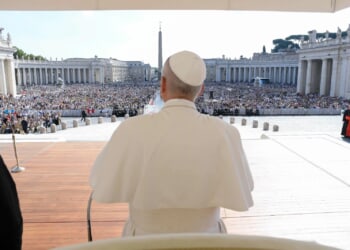
KYIV — After swelling to about one million soldiers at the beginning of Russia’s 2022 invasion, the Ukrainian army is struggling to replenish its ranks. Enlistments have declined sharply, forcing Kyiv to rely increasingly on mandatory mobilization.
Kyiv’s recruitment woes are compounded by the country’s dire demographic situation — with 6.5 million Ukrainians having fled the country and about 3 million now living under Russian occupation, Ukraine’s population has shrunk from a pre-war total of 41 million to about 28 to 30 million.
With the manpower shortage, Ukraine is desperate for cash to attract new recruits, prompting President Volodymyr Zelenskyy last month to ask Europe to help him boost military pay for new recruits.
“Previously, Europeans refused to provide funding for the salaries of our military personnel, only for weapons. Our service members themselves can be the weapon that protects everyone,” Mr. Zelenskyy told reporters on July 25.
While it remains to be seen whether his request will be accepted, the announcement coincides with mounting Russian pressure in Ukraine’s eastern Donetsk and Sumy regions, and growing recruitment challenges within the Ukrainian army.
After more than three years of brutal attritional warfare, the initial patriotic surge that had led tens of thousands of Ukrainians to enlist in the early months of the war has waned. Much of the population willing and able to serve has already joined the army, and many have since been wounded, killed, or exhausted by repeated deployments.
In 2024, according to then-Defense Minister Rustem Umerov, only about 12% of new recruits had joined voluntarily, while the rest were conscripted — mobilized under legal mandates that have sparked criticism from civil society and human rights groups.
Street protests have erupted after social media videos emerged showing recruitment officers violently yanking conscripts off streets and whisking them away in vans to be inducted into the military. On Friday, according to the Financial Times, a crowd of 80 protesters in the central Ukrainian city of Vinnytsia tried to break through security at a stadium being used as a recruitment center to free recently mobilised conscripts.
The manpower shortage is severe enough that Mr. Zelenskyy recently signed a law allowing volunteers 60 and older to join. The average Ukrainian soldier is already 40 or older, as Mr. Zelenskyy has resisted calls to lower the conscription age below the limit of 25, saying he would not sacrifice the country’s next generation to the war effort.
In recent months, the Ukrainian government has launched several initiatives to revive its flagging recruitment drive, such as the “Contract 18–24” program, which offers up to 1 million hryvnias (about $24,000) in sign-up bonuses, attractive wages and free university tuition, as well as mortgage incentives for young enlistees. However, the program has so far encountered little success, with only about 500 people signed up as of May.
With a population of over 140 million people, Russia remains able to field a much larger force, although Vladimir Putin’s army has paid a steep cost for his ambitions: According to a June 2025 assessment of the British defense intelligence, Russia had suffered over one million combat losses since the war began, including roughly 250,000 killed or missing.
Meanwhile, a new analysis published by the KSE Institute cites a sharp reduction in Russia’s once-substantial stockpiles of Soviet-era equipment and weapons: Shipments from storage depots to the front plunged from 242,000 tons in 2022 to an estimated 119,000 tons in 2025, with analysts warning that the most serviceable and easily refurbished equipment has already been deployed.
In spite of heavy losses, Kyiv says that Moscow is still fielding close to 700,000 troops in Ukraine, while the Russian Ministry of Defence claims to be recruiting between 50,000 and 60,000 new soldiers each month. In 2024 alone, Russia reportedly signed over 430,000 new military contracts. This recruitment effort is backed by substantial cash incentives, with bonuses exceeding five times the average Russian monthly wage, as well as preferential access to housing, and even reduced prison sentences for convicts who agree to serve.
Still, Russia’s demographic outlook is not much rosier: the country’s population is shrinking, thanks to a combination of low birth rates, war casualties and an exodus of military-age men seeking to avoid conscription.
Hoping to bolster their war effort, Russia and Ukraine alike have welcomed foreign volunteers to join their ranks. While their exact number is hard to ascertain, estimates suggest several thousand foreigners are currently serving in Ukraine, many of them within the ranks of Ukraine’s International Legion, an outfit composed of volunteers from over 100 countries.
Russia has similarly drawn from its prisons and from foreign recruits and is increasingly leaning on its allies for ammunition and manpower. Most notably, thousands of North Korean soldiers were deployed alongside Russian forces in late 2024 in Russia’s disputed Kursk region. Credible reports have also surfaced of foreign migrants from Africa, Central Asia and Nepal being misled or coerced into signing Russian military contracts under false pretenses, having been promised jobs or student visas.
This practice recently made headlines after a U.S. citizen was reportedly deceived into joining the fight in Ukraine: After relocating with his family from Texas to Russia in early 2025 to escape “woke” values, Derek Huffman enlisted with assurances he would be given a non-combat position, in a bid to expedite the process of acquiring Russian citizenship. Within weeks, however, he was abruptly assigned to an infantry role on the Ukrainian front despite limited Russian language skills and minimal training. His wife DeAnna later lamented that he had been “thrown to the wolves” and claimed that her husband was yet to receive the money he’s owed for his service.
The diplomatic situation, meanwhile, has grown more volatile: On July 29, U.S. President Trump issued a sharp ultimatum to the Kremlin, shortening an earlier 50-day timeline for a ceasefire agreement to just 10 to 12 days — a deadline that falls this coming weekend. The move includes threats of sweeping secondary sanctions and 100% tariffs on countries continuing to buy Russian oil.
Russian officials said they had “taken note” of the deadline but dismissed it as ineffectual. “Russia is immune to these threats,” said Foreign Ministry spokesperson Maria Zakharova. “We do not respond to ultimatums.” Earlier, Kremlin press secretary Dmitry Peskov had accused Kyiv and the West of rejecting all serious peace proposals and reaffirmed that Russia would not normalize relations with Ukraine or NATO until its “military objectives” were fully achieved.
On Wednesday, Mr. Trump seemingly made good on his threat, announcing he would impose a 25% tariff on goods from India as well as an additional import tax, reasoning that New Delhi’s purchases of military equipment and oil from Russia had enabled the war in Ukraine.
Still, even as Mr. Trump shows growing irritation at Moscow’s unwillingness to negotiate, the diplomatic chessboard remains frozen.





![Gavin Newsom Threatens to 'Punch These Sons of B*thces in the Mouth' [WATCH]](https://www.right2024.com/wp-content/uploads/2025/08/Gavin-Newsom-Threatens-to-Punch-These-Sons-of-Bthces-in-350x250.jpg)
![ICE Arrests Illegal Alien Influencer During Her Livestream in Los Angeles: ‘You Bet We Did’ [WATCH]](https://www.right2024.com/wp-content/uploads/2025/08/ICE-Arrests-Illegal-Alien-Influencer-During-Her-Livestream-in-Los-350x250.jpg)








